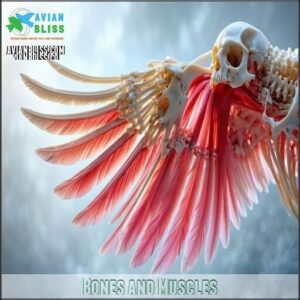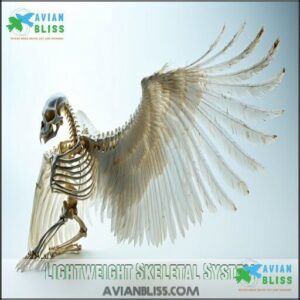This site is supported by our readers. We may earn a commission, at no cost to you, if you purchase through links.

Primary feathers provide thrust, while secondary ones handle lift. Penguins’ wings act like flippers, while soaring birds have broad wings to catch air currents.
Even the tiniest songbird’s wings are aerodynamic masterpieces, allowing agile flight. The lightweight skeleton, paired with precise feather control, makes birds masters of the skies.
Some species, like flightless emus, use wings for balance rather than flight. Wings reveal nature’s creative engineering—each design serves a purpose uniquely suited to survival, showcasing unique adaptations and creative solutions.
Table Of Contents
- Key Takeaways
- Bird Wing Structure
- Wing Shapes and Sizes
- Flight Mechanics Explained
- Feather Types and Functions
- Wing Adaptations and Diversity
- Frequently Asked Questions (FAQs)
- What are the facts about wings?
- What is the function of a bird wing anatomy?
- What are bird’s wings made of?
- What are the parts of a bird’s wings?
- How do bird wings respond to injuries?
- What causes variations in wing colors among birds?
- How do birds manage wing hygiene?
- What role do wings play in bird courtship?
- How do bird wings adapt during migration?
- Conclusion
Key Takeaways
- You’ll notice bird wings combine lightweight bones, strong muscles, and specialized feathers, making them perfectly designed for flight and movement.
- Different wing shapes, like elliptical or soaring wings, reflect how birds adapt to their environment and specific flight needs.
- Feather structure and control, including barbs and barbules, are key to creating lift, reducing drag, and enabling precision in flight.
- Birds regularly preen and replace feathers (molting) to maintain peak flight efficiency and ensure their wings stay functional.
Bird Wing Structure
You’ll find that a bird’s wing is an impressive combination of bones, muscles, and feathers working together seamlessly.
Its lightweight yet durable structure is built for strength, flexibility, and efficient flight.
Bones and Muscles
Bird wings are marvels of engineering. The lightweight bird skeleton, with hollow wing bones, supports flight without excess skeletal weight.
Lightweight skeletons and hollow bones make bird wings extraordinary structures, combining strength and agility for effortless, efficient flight.
Muscles attached to sturdy wing bones like the humerus, radius, and fused metacarpus provide precise muscle control. The coracoid aids chest stability, anchoring flight muscles.
Bone fusion strengthens the wing while maintaining flexibility, helping birds adapt effortlessly to the sky. Some birds even have fused collarbones that further stabilize their wings, making them highly adaptable to the sky with precise muscle control and a lightweight skeleton.
Feather Attachment
Feathers, like nature’s Velcro, are masterfully anchored to a bird’s wing bones.
The quill structure attaches securely, ensuring flight. Primary and secondary feathers align for lift, while covert feathers smooth airflow.
Barbule interlocking adds strength, keeping feathers intact. Understanding feather attachment products can further clarify the process.
During the molting process, worn-out feathers are replaced, ensuring peak efficiency for every flight. Feather anatomy truly defines precision and beauty!
Feather molting ensures birds maintain peak flight performance, showcasing the elegance and precision of their beautifully engineered anatomy.
Lightweight Skeletal System
A bird’s skeletal framework is built for flight through lightweight skeletal adaptations.
Hollow bones with a honeycomb structure reduce weight without compromising strength. Bone fusion in the wings guarantees rigidity for feather attachment and stability.
Air sacs, integral to avian anatomy, enhance breathing while promoting weight reduction. These clever features make bird wings marvels of engineering.
| Feature | Purpose | Benefit | Example |
|---|---|---|---|
| Honeycomb Structure | Lightweight strength | Efficient flight | Humerus |
| Bone Fusion | Stability | Precise control | Metacarpus |
| Air Sacs | Better oxygen flow | Weight reduction | Lungs |
| Hollow Bones | Reduced mass | Easier lift-off | Radius & Ulna |
The combination of these features, including hollow bones and air sacs, contributes to the remarkable ability of birds to fly efficiently.
Wing Shapes and Sizes
Birds have wings in many shapes and sizes, each designed to suit their specific environments and lifestyles.
From compact, rounded wings for quick takeoffs to long, narrow ones for soaring, a wing’s shape determines how a bird flies and survives.
Ground-Dwelling Birds
Ground-dwelling birds use their unique wing structure and morphology for rapid escape flights.
Their short, rounded wings boost predator evasion in dense habitats. Camouflage feathers blend with surroundings, protecting nests and chicks.
Habitat impact influences their wing development, adapting for quick takeoffs and precise maneuvers. This avian anatomy highlights their reliance on swift bursts of speed over sustained flight, showcasing the importance of rapid escape flights.
Soaring Birds
Unlike ground-dwelling species, soaring birds like eagles, vultures, and albatrosses master energy conservation through thermal utilization.
Their broad wings and unique soaring adaptations harness rising air currents, enabling effortless, long-lasting flights.
Wing aerodynamics optimize avian flight by reducing drag, while precise feather control enhances flight efficiency.
Streamlined bodies aid their ability to minimize drag.
Whether gliding majestically or crossing continents during migration patterns, these bird wings reveal remarkable insights into bird anatomy and soaring flight techniques.
Songbirds
While soaring birds ride thermals with minimal effort, songbirds showcase entirely different wing adaptations.
These passerines display slightly pointed wings perfectly suited for their lifestyle:
- Their elliptical wing shape enables quick takeoffs from branches and agile maneuvering through forest canopies
- Wing feathers create excellent lift for short daily flights between perching spots
- Songbird flight patterns balance energy efficiency with the need for precise navigation during migration
Claude can help with a wide range of writing tasks, including expanding on this topic or helping with another section of your article on bird wing anatomy. Would you like me to assist with this or another section, focusing on key aspects such as energy efficiency or wing adaptations?
Seabirds
While songbirds flutter through forests with their elliptical wings, seabirds command the open oceans with specialized wing designs.
You’ll notice their long, narrow wings perfectly suited for gliding over vast distances.
| Seabird | Wing Design | Flight Pattern |
|---|---|---|
| Albatross | Extremely long, narrow | Dynamic soaring |
| Penguin | Short, stiff "flippers" | Underwater "flight" |
| Puffin | Compromise design | Both aerial and underwater |
| Gull | Moderate length, pointed | Active soaring |
| Petrel | Long, thin with high aspect ratio | Dynamic/slope soaring |
These adaptations allow efficient flight patterns with minimal energy expenditure, enabling seabirds to thrive in their open oceans environment through dynamic soaring and other unique flight capabilities, making their specialized wing designs a key factor in their survival.
Flight Mechanics Explained
You’ll notice that a bird’s wing functions as an airfoil, creating lift when air moves faster over the curved upper surface than the flatter bottom surface.
During flight, birds constantly adjust their wing shape and angle, compressing feathers on the downstroke for lift and separating them on the upstroke to reduce resistance.
Wing Movement
Understanding wing movement reveals the extraordinary mechanics behind bird flight.
During flight, bird wings move forward on upstroke and push back on downstroke power, creating both lift and thrust.
Wing muscles control flapping frequency while wing joints enable precise steering control.
You’ll notice feather adjustment happens constantly – wings compress on downstroke for maximum power and separate during upstroke mechanics to reduce resistance.
This coordinated movement allows for remarkable flight control, with the wings moving in a way that enables precise steering.
Feather Control
Bird wings move with precision during flight thanks to remarkable feather control.
You’ll notice birds constantly adjust their feathers’ position and arrangement through sophisticated muscle coordination.
The feather microstructures — barbs and barbules — lock together like Velcro, creating a unified surface that responds to air pressure.
Regular preening behavior maintains this system, as birds coat feathers with oil to preserve their aerodynamic function despite environmental factors like rain or wind.
This process is supported by specialized preening oils that birds use.
Aerodynamics
The remarkable aerodynamics of bird wings function through four primary forces: lift, thrust, drag, and weight.
When you examine a wing’s cross-section, you’ll notice its curved upper surface creates lower pressure above while the flatter bottom generates higher pressure—this airfoil design produces lift.
Wingtip vortices are minimized through specialized feather structures, improving flight stability and reducing drag during avian flight.
Body Streamlining
Like a precision-engineered aircraft, a bird’s streamlined shape cuts through air resistance.
You’ll notice their aerodynamic profile features feather alignment pointing backward, minimizing drag. Their body posture remains compact during flight, with leg position tucked up against the body.
Even nostril direction on many species faces backward!
Weight-saving adaptations include hollow bones and air sacs, while wing shape varies by species for superior performance in different environments.
Feather Types and Functions
You’ll find that a bird’s wing contains various feather types, each engineered for specific aerodynamic functions from the thrust-generating primaries at the wingtip to the stabilizing coverts near the body.
These specialized feathers work together in precise arrangement to create lift, reduce drag, and enable the remarkable flight capabilities that allow birds to navigate their environments with efficiency.
Primary Feathers
After understanding the mechanics of flight, you’ll notice primary feathers are the powerhouses of bird wings.
These large, asymmetrical flight feathers attach to the wing’s outer portion, creating thrust during downstrokes. You can identify them at the leading edge, where they’re designed for drag reduction while pushing air backward.
These feathers are essential for generating thrust and lift, but other feather types aid in insulation and display.
When birds molt, replacing these feathers happens sequentially to maintain flight ability—nature’s clever solution to feather structure maintenance.
Secondary Feathers
Moving from the wing’s outer edge, you’ll find secondary feathers attached along the ulna bone. These symmetrical flight feathers provide substantial lift contribution during soaring, enhancing flight stability.
While a bird typically has 10-14 secondary feathers, this count varies by species. Their overlapping structure creates a continuous surface that maximizes soaring efficiency.
During molting, birds replace these feathers sequentially to maintain wing anatomy integrity.
Coverts and Tertials
When you look at a bird’s wing, coverts and tertials play vital roles you mightn’t notice.
Coverts are small feathers that overlap the bases of flight feathers, creating a smooth wing surface essential for efficient aerodynamics.
Tertials, positioned closest to the body on the wing’s trailing edge, provide stability during flight.
Their feather arrangement guarantees proper wing smoothness while offering insulation properties that protect larger feathers from damage.
Many enthusiasts purchase bird coverts for various projects.
Alula Feathers
You’ll notice a small group of feathers called the alula on the leading edge of bird wings. Often referred to as the "bastard wing," this thumb-like structure serves a vital role in flight control.
The alula provides:
- Precise airflow control at low speeds
- Stall prevention during steep angles of attack
- Enhanced maneuverability during landing and takeoff
This evolutionary adaptation functions like aircraft slats, enabling birds to maintain lift during critical flight phases, which is crucial for precise airflow control.
Wing Adaptations and Diversity
You’ll find that birds’ wings have evolved into remarkable adaptations that perfectly match their lifestyles and habitats, from the elliptical wings of forest songbirds to the long, narrow wings of ocean-soaring albatrosses.
These specialized wing designs demonstrate nature’s engineering precision, allowing different species to excel at specific flight tasks like hovering, high-speed pursuit, effortless gliding, or in some cases, adapting wings for swimming or simply reducing them when flight isn’t necessary, which showcases their ability to achieve effortless gliding.
Elliptical Wings
Elliptical wings give birds remarkable maneuverability advantages in complex environments.
You’ll find this wing morphology in forest-dwelling songbirds and woodland raptors where habitat correlation is evident.
Their compact, rounded shape enables quick takeoff efficiency and tight turns—perfect for predator evasion through dense vegetation.
While not ideal for sustained flight, bird wings with this elliptical design excel at burst acceleration and precision navigation, allowing species like robins and sparrows to thrive in cluttered spaces.
High-Speed Wings
High-speed wings represent nature’s engineering marvel for swift flight.
You’ll find these slender, pointed wings on falcons, swifts, and terns—birds that prioritize velocity over maneuverability.
Their design features increased wing loading and requires rapid wingbeats, creating an energetically expensive but incredibly fast flight pattern.
This aerodynamic structure minimizes drag, allowing ducks, swallows, and peregrine falcons to maintain impressive speeds while demonstrating remarkable falcon aerodynamics and specialized tern adaptations.
These wings often feature primary feathers for thrust, aiding in speed control.
Soaring Wings
Soaring wings have evolved to master thermal utilization with remarkable efficiency.
You’ll find two distinct types: passive soaring wings (like the albatross) with long, narrow shapes perfect for constant ocean winds, and active soaring wings (like eagles and vultures) featuring deep slots between primaries to reduce drag.
These specialized adaptations minimize wing loading, conserve flight muscles, and enable birds to achieve impressive flight altitudes during long migration patterns, showcasing their ability to conserve flight muscles.
Hovering Wings
While some birds excel at soaring effortlessly on air currents, hovering wings represent a marvel of avian engineering.
You’ll find these small, quick wings on hummingbirds, kestrels, and kingfishers.
Hummingbirds can beat their wings up to 80 times per second, rotating them to create lift on both down- and upstrokes, which enables precise hovering during nectar feeding, though it demands extraordinary energy expenditure.
Remarkably, hummingbirds can even achieve backwards flight through their unique wing oscillation patterns.
Flightless Birds
While hovering birds showcase specialized wing adaptations, some species have undergone evolutionary loss of flight entirely.
You’ll notice flightless birds like penguins have modified wing structures serving as flippers for underwater "flight."
Ostriches and emus demonstrate significant wing reduction, with their wing anatomy adapted for balance and courtship displays rather than aerial movement.
These avian adaptations reflect habitat impact—whether terrestrial or aquatic—and often present unique conservation challenges due to their alternative locomotion strategies, which involve specialized wing adaptations and evolutionary loss of flight, leading to unique conservation challenges and requiring alternative locomotion strategies.
Frequently Asked Questions (FAQs)
What are the facts about wings?
Wings, nature’s masterpiece, fuse lightweight bones and precise muscles, enabling graceful flight.
Connected to a streamlined body, feathers create lift, thrust, and flexibility.
Shapes vary—from swift speedsters to soaring gliders—perfectly adapting birds to their environments.
What is the function of a bird wing anatomy?
A bird’s wing gives it the power of flight, shaping air to generate lift and thrust.
Its bones, muscles, and feathers work together, allowing agile movement, adaptation to environments, and precise control during soaring or gliding.
What are bird’s wings made of?
A bird’s wings combine lightweight bones, strong muscles, and specialized feathers.
Hollow bones reduce weight, muscles control movement, and feathers—like primaries for thrust, secondaries for lift—create the perfect balance for flying and soaring effectively, utilizing specialized feathers.
What are the parts of a bird’s wings?
Think of a bird’s wing as a masterpiece of engineering.
It includes bones like the humerus, radius, and ulna, along with muscles, feathers, and key structures like the alula, coverts, and flight feathers.
How do bird wings respond to injuries?
When a wing’s injured, it disrupts a bird’s flight, balance, and survival.
Birds often avoid flying to protect the damage.
Proper rest and limited stress allow healing, though severe breaks might need intervention or lead to disability.
The healing process is crucial for the bird’s survival.
What causes variations in wing colors among birds?
Variety is the spice of life" applies to wing colors, too.
Pigments like melanin and carotenoids, structural coloration, and diet all influence hues.
These variations help with camouflage, mate attraction, or signaling species identity.
How do birds manage wing hygiene?
Maintaining wing hygiene, birds preen their feathers daily using their bills to realign barbs and remove debris.
They also bathe in water or dust to control parasites, ensuring feathers stay clean, functional, and flight-ready.
What role do wings play in bird courtship?
Amazingly, 90% of bird species rely on their wings during courtship displays.
They’ll flutter, spread, or vibrate them, attracting mates by showcasing strength, health, and vigor—aerial acrobatics say, “I’m fit and ready to pair!”
How do bird wings adapt during migration?
During migration, birds adapt their wings by adjusting shape and feather positioning to maximize lift and minimize energy use.
Long, narrow wings improve efficiency for sustained flight, while feather overlap reduces turbulence, ensuring smoother, longer journeys with minimal energy expenditure.
Conclusion
Like a puzzle fitting perfectly together, bird wings demonstrate intricate design and purpose.
Their unique anatomy—lightweight bones, powerful muscles, and specialized feathers—enables diverse flight abilities and survival strategies.
From the efficient thrust of primary feathers to the lift managed by secondaries, each part plays a role.
Wing shapes vary to meet different needs, whether for soaring, speed, or hovering.
By studying facts about bird anatomy wings, you’ll uncover nature’s remarkable ingenuity in flight and function.













